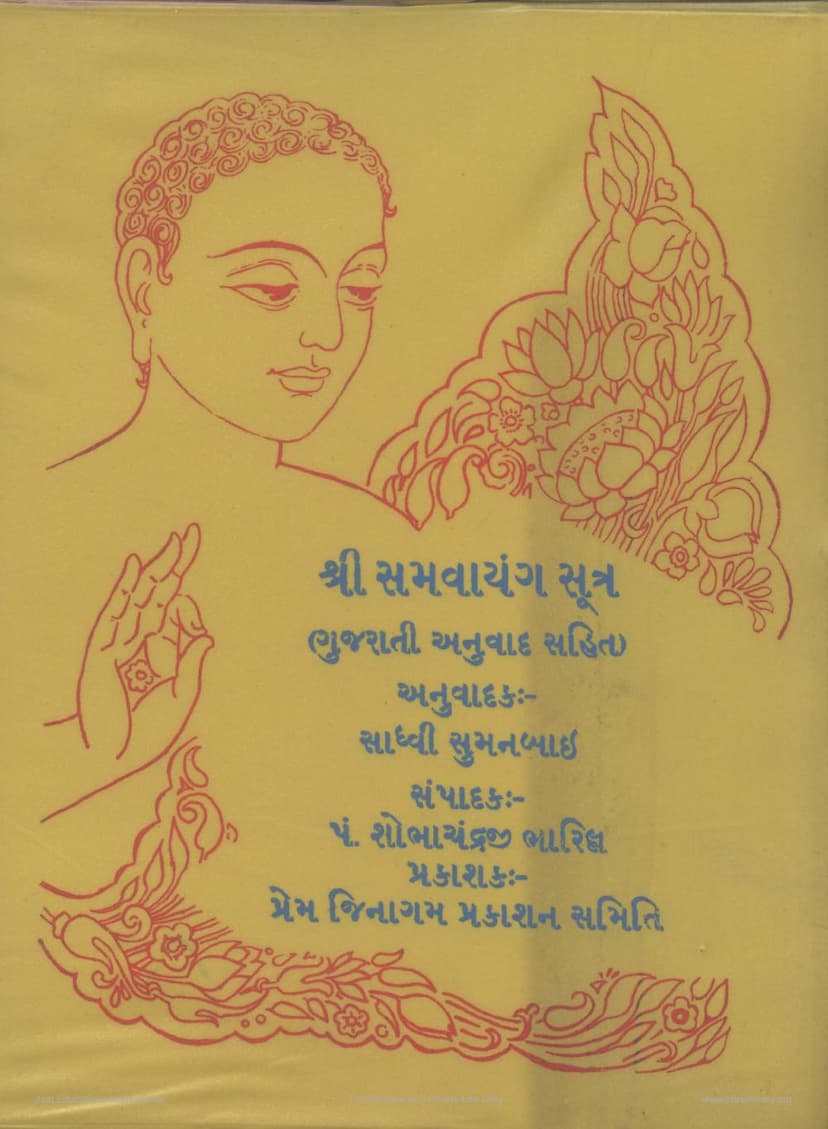Agam 04 Ang 04 Samvayang Sutra
Added to library: September 1, 2025

Summary
The provided text is the Gujarati translation and commentary of the Samvayang Sutra, the fourth Anga of the Jain Agamas, compiled by Acharya Jinagam Prakashan Samiti. The translation and editing were done by Sadhvi Sumanbai and Pandit Shobhachandrji Bharilla respectively. This particular edition was published in 1980 (Samvat 2035) and commemorates the 2500th Nirvana Mahotsava of Lord Mahavir.
Here's a comprehensive summary of its content, based on the provided pages:
Overall Purpose and Structure:
The Samvayang Sutra (also referred to as Samvaya or Samvaye) is structured around the concept of "Samvaya," which means collection, gathering, or combination. The core purpose of the Sutra is to present a vast compilation of Jain principles, entities, and classifications, often categorized numerically from one upwards. This approach is similar to the Shanasthana Sutra in its stylistic presentation.
Key Content Areas:
The Sutra systematically enumerates and explains various Jain concepts, often linking them to specific numbers. The provided text highlights the following key areas covered in the Samvayas (chapters or sections) of the Sutra:
-
Numbers and Their Significance: The Samvayas are primarily organized around numbers, starting from one and going up to very large numbers, including crores and further. For each number, the Sutra lists various Jain categories, concepts, or beings associated with it. For example:
- One (Ek): Deals with 18 fundamental substances (Jiva, Ajiva, etc.), details about Jambudvipa, planets, constellations, and lifespans of various beings in different realms.
- Two (Dvi): Covers concepts like two types of punishment, two types of collections, two types of bonds, and stars within constellations.
- Three (Tri): Discusses three types of punishment, three secrets, three shalyas (afflictions), three gravities, and three violations. It also mentions the lifespans of certain beings in relation to the number three.
- Four (Chatvari): Encompasses four passions (kashayas), four types of meditation, four types of discussions, four types of knowledge, and four types of karma bondage.
- Five (Pancha): Details five types of actions (kriya), five great vows (mahavrata), five types of sensory pleasures, five influxes of karma (ashrava), five restraints of karma (samvara), five stages of purification of karma (nirjala), five types of samitis (careful conduct), and five astikayas (fundamental substances).
- Six (Sha-): Covers six types of colored dispositions (leshya), six types of living beings (jiva), six types of external austerities, six types of internal austerities, six types of outward manifestations of soul (samudghata), and six types of intellectual grasping (arthagraha).
- Seven (Sapta): Discusses seven types of fear, seven types of samudghatas, the height of Lord Mahavir, seven great mountain ranges, seven continents, and how beings experience karmic fruition.
- Eight (Ashta): Deals with eight sources of merit (sadsthana), eight maternal figures of speech (pravachan mata), names of celestial trees, and the height of Mount Meru. It also mentions the eight moments of Kevali Samudghata and the eight Gannadharas of Lord Parshvanatha.
- Nine (Nava): Covers nine types of celibacy (brahmacharya), and the height of Lord Parshvanatha.
- Ten (Dasha): Details ten types of monastic conduct, ten places of mental concentration, the height of Mount Meru, and the lifespans of various beings. It also mentions ten types of wish-fulfilling trees and ten constellations that enhance knowledge.
- This pattern continues with higher numbers, systematically detailing:
- Eleven (Ekadasha): Eleven stages of a lay follower (shravak pratima), eleven classes of celestial beings, and lifespans.
- Twelve (Dvadasha): Twelve stages of monks, twelve types of association, twelve verses of a ritual, lifespans, the dimensions of various realms, and twelve months in a year. It also includes details about the twelve chakravartis and their lifespans.
- Higher numbers: The Sutra systematically lists numerous concepts associated with each subsequent number, including:
- Thirteen to Forty-Six: Various concepts related to lifespans, cosmology, celestial beings, spiritual stages, types of sins, virtues, karma, ascetics, disciples, rulers (like chakravartis, baladevas, vasudevas), geographical features, astronomical data, and the lifetimes of various beings and spiritual leaders.
- Up to Lakhs and Crores: The Sutra extends to very large numbers, enumerating concepts related to the duration of cycles, the number of villages, cities, kingdoms, the extent of geographical features, and the lifespans of beings across different realms, reaching into crores and even more.
- Specific Personalities and Events: It often connects these numbers to significant figures in Jain history like Tirthankaras, Chakravartis, Baladevas, Vasudevas, and their families, as well as key events and timelines in the Jain universe.
- Dwadashanga Ganipitaka: A significant portion of the Sutra is dedicated to explaining the twelve Angas of the Jain canon, detailing their contents and significance.
- Miscellaneous Topics: The text also touches upon miscellaneous subjects like the origin of the universe, the properties of substances, and the principles of conduct.
-
The Meaning of "Samvaya": The title "Samvaya" is explained as meaning the gathering or collection of Jiva (soul) and Ajiva (non-soul) substances with their respective qualities and forms, enumerated through numbers. The "Sam" implies completeness, "Vaya" implies form and limit, and "Aya" implies classification or counting.
-
Praise for the Publisher and Patron: The text expresses gratitude to the "Prem-Jinaagam Prakashan Samiti" and specifically mentions Shri Premji Hirji Gala as a religious patron whose contribution enabled the Gujarati translation and publication of this important Jain text. Shri Jechandbhai Jamnadas Tejani and Shri Harjivandas Rughnath Gandhi are also mentioned in a similar context.
-
Corrigenda (Shuddhi Patra): The text includes a "Shuddhi Patra" which lists corrections for errors found in the printed text, indicating a careful editorial process.
Overall Impression:
The Samvayang Sutra, as presented in this Gujarati edition, is a monumental work of Jain literature. It aims to provide a comprehensive and systematic catalog of Jain cosmology, philosophy, and history, all organized through the lens of numerical classification. It highlights the interconnectedness of various Jain concepts and the detailed understanding of the universe as presented in Jain scripture. The inclusion of Gujarati translation makes this profound text accessible to a wider audience.